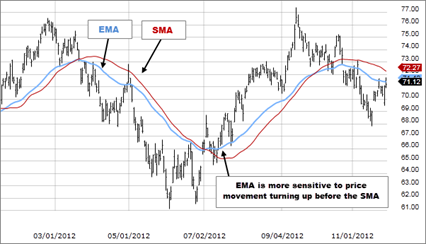Exponential Moving Average (EMA) is similar to Simple Moving Average (SMA), measuring trend direction over a period of time. However, whereas SMA simply calculates an average of price data, EMA applies more weight to data that is more current. Because of its unique calculation, EMA will follow prices more closely than a corresponding SMA.
The aim of all moving averages is to establish the direction in which the price of a security is moving based on past prices. Therefore, exponential moving averages are lag indicators. They are not predictive of future prices; they simply highlight the trend that is being followed by the stock price.
The chart below shows how the price of Apple’s stock (NASDAQ: AAPL) changed over a six-month period. Each candlestick shows how the price of the stock changed over one trading day (there are, on average, 21 trading days in a month), with green candlesticks indicating a rise in the stock price and red candlesticks representing price drops.
Calculation
You should notice how the EMA uses the previous value of the EMA in its calculation. This means the EMA includes all the price data within its current value. The newest price data has the most impact on the Moving Average and the oldest prices data has only a minimal impact.
EMA = (K x (C – P)) + P
Where:
C = Current Price
P = Previous periods EMA (A SMA is used for the first periods calculations)
K = Exponential smoothing constant
The smoothing constant K applies appropriate weight to the most recent price. It uses the number of periods specified in the moving average.
How it works?
Use the same rules that apply to SMA when interpreting EMA. Keep in mind that EMA is generally more sensitive to price movement. This can be a double-edged sword. On one side, it can help you identify trends earlier than an SMA would. On the flip side, the EMA will probably experience more short-term changes than a corresponding SMA.
Use the EMA to determine trend direction, and trade in that direction. When the EMA rises, you may want to consider buying when prices dip near or just below the EMA. When the EMA falls, you may consider selling when prices rally towards or just above the EMA.
Moving averages can also indicate support and resistance areas. A rising EMA tends to support the price action, while a falling EMA tends to provide resistance to price action. This reinforces the strategy of buying when the price is near the rising EMA and selling when the price is near the falling EMA.
All moving averages, including the EMA, are not designed to identify a trade at the exact bottom and top. Moving averages may help you trade in the general direction of a trend, but with a delay at the entry and exit points. The EMA has a shorter delay than the SMA with the same period.







